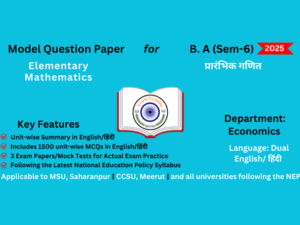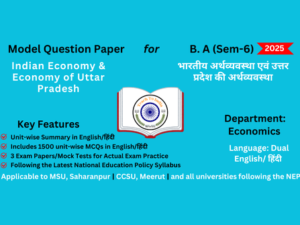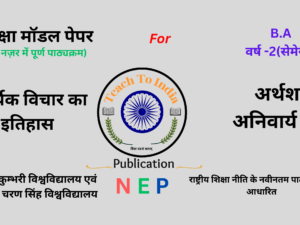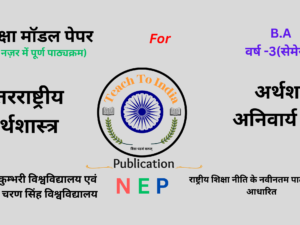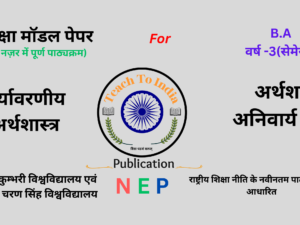सूक्ष्मअर्थशास्त्र के सिद्धांत (सेमेस्टर -1)
- Description
- Curriculum
- Reviews
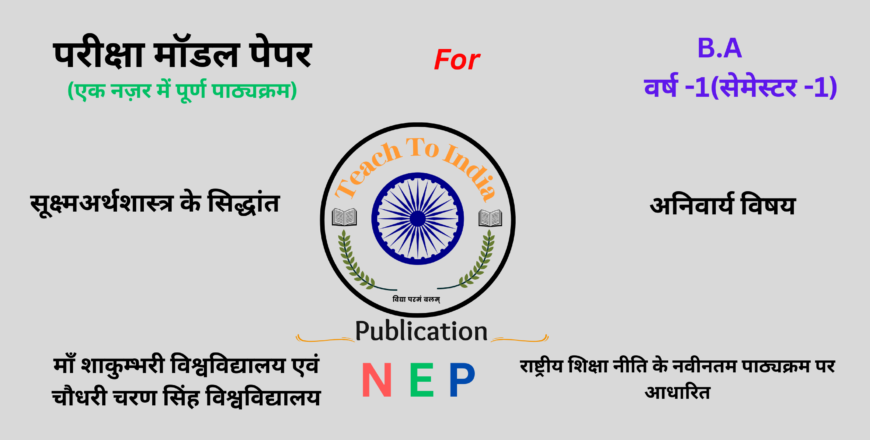
Teach To India प्रकाशन
सूक्ष्मअर्थशास्त्र के सिद्धांत
-
यह मॉडल पेपर यह सुनिश्चित करता है कि सभी संभावित प्रश्न जो परीक्षा में आ सकते हैं, वे यूनिट में पूरी तरह से शामिल हैं, चाहे वे सीधे हों या अप्रत्यक्ष रूप से।
-
इसे अनुभवी प्रोफेसरों द्वारा बहुत सावधानी से तैयार किया गया है, जिन्हें परीक्षा मॉडल पेपर बनाने का व्यापक अनुभव है।
-
इस पेपर में विश्वविद्यालय द्वारा निर्धारित पाठ्यक्रम के आधार पर सभी मुख्य प्रश्न शामिल हैं।
-
200 से अधिक प्रश्न और उत्तरों के साथ, यह मॉडल पेपर विषय का पूरा पाठ्यक्रम कवर करता है।
-
प्रत्येक यूनिट में दीर्घ उत्तरीय ,लघु उत्तरीय और अति लघु उत्तरीय वाले प्रश्न शामिल हैं ताकि छात्रों को गहन समझ प्राप्त हो सके।
-
हमारे प्रश्न इस तरह तैयार किए गए हैं कि प्रत्येक यूनिट को कम से कम और अच्छी तरह चुने हुए प्रश्नों से कवर किया जा सके।
-
इस मॉडल पेपर में मॉक प्रश्नपत्र / पिछले साल के प्रश्नपत्र भी हल के साथ दिए गए हैं, जिससे छात्रों को परीक्षा के प्रश्नों की गहराई और विस्तार को समझने में मदद मिलती है।
|
Programme /Class: Certificate |
Year: First |
Semester: Ist |
||
|
Co-Curricular Course |
||||
|
Course Title: Principle of Micro Economics |
||||
|
Course Outcome: The students are familiarized with basic concepts of microeconomics such as laws of demand and supply and elasticity etc so that he/she can comprehend them & familiarize with day today happenings. The students learn and understand the concepts of consumer behaviour like cardinal utility and ordinal utility analysis.
The sturtents learn and understand application of Indifference curve analysis in deriving demand curves, price effect, income effect and substitution effect. The students learn and understand the Theory of production-iso-quants, laws of returns to scale, law of variable proportion.
The students learn, understand and compare between the Traditional and modem theory of cost. Demonstrate an understanding, usage and application of basic economic principles. Describe and apply the methods for analyzing consumer behavior through demand and supply, elasticity and marginal utility.
To analyze the behavioral patterns of different economic agents regarding profit, price, cost etc. The decision-making process in different market situations such as perfect competition, monopolistic competition, monopoly and oligopoly markets.
|
||||
|
Credits: 6 |
Core Compulsory |
|||
|
Max. Marks: 25+75 |
Min. Passing Marks: 8+25 |
|||
|
Unit |
Topics |
|||
|
I |
Introduction: Definitions of Economics, Demand and Supply, Law of Demand, Determinants of Demand, Shifts of Demand versus movements along a demand curve, Law of Supply, Determinants of Supply versus movements along a supply curve, Consumer’s Surplus. Elasticity: price elasticity of demand, calculating elasticity, determinants of price elasticity, other elasticities.
|
|||
|
II |
Consumer Theory: concept of utility, diminishing marginal utility, Cardinal Versus Ordinal approach, Consumer choice: indifferencecurves, Characteristics of Indifference curve, Consumer’s Equilibrium through indifference curve.
|
|||
|
III |
Production and Costs – Production function, law of variable proportions, Returns to scale, Isoquant and isocost lines, cost minimizing equilibrium condition, Cost – Marginal Cost Average cost, total cost, fixed cost and variable cost, apportunity cost, Costs in short run and costs in the long run, revenue and profit maximization.
|
|||
|
IV |
Masket Structure – (a) Perfect Competition- Salicut features of perfect competition, pure competition, equilibrium of the fim in the short run and long term industry supply curve: increasing decreasing and constant cost industry. (b) Imperfect competition – Monopolistic competition. Salicut characteristics of monopolistic competition, short run and long run price and output determination under monopolistic Compilation, Economic efficiency and resource allocation.
|
|||
|
V |
Theory of a Monopoly firm -Chracteristics of monopoly, short run and long run price and output determination of monopoly firm, Comparison of perfect competition and monopoly, Social cost of monopoly, natural monopoly.
|
|||
|
VI |
Consumer and Producer Theory – Extemalities, internalising extemalities, Public goods, imperfect information, advarse selection, moral hazard, social choice, government inefficiency.
|
|||
|
VII |
Income Distribution and factor pricing: Theory of rent, Wages interest and Profit.
|
|||
|
VIII |
Welfare Economics – Concept and Definition of Welfare Economics; Normative and Positive Economics, Concept of social welfare, Role of value judgement in welfare economics, Pareto Optimality, Conditions of Pareto Optimality.
|
|||
-
1यूनिट-1: सूक्ष्मअर्थशास्त्र के सिद्धांत
-
2यूनिट-2: सूक्ष्मअर्थशास्त्र के सिद्धांत
-
3यूनिट-3: सूक्ष्मअर्थशास्त्र के सिद्धांत
-
4यूनिट-4: सूक्ष्मअर्थशास्त्र के सिद्धांत
-
5यूनिट-5: सूक्ष्मअर्थशास्त्र के सिद्धांत
-
6यूनिट-6: सूक्ष्मअर्थशास्त्र के सिद्धांत
-
7यूनिट-7: सूक्ष्मअर्थशास्त्र के सिद्धांत
-
8यूनिट-8: सूक्ष्मअर्थशास्त्र के सिद्धांत

